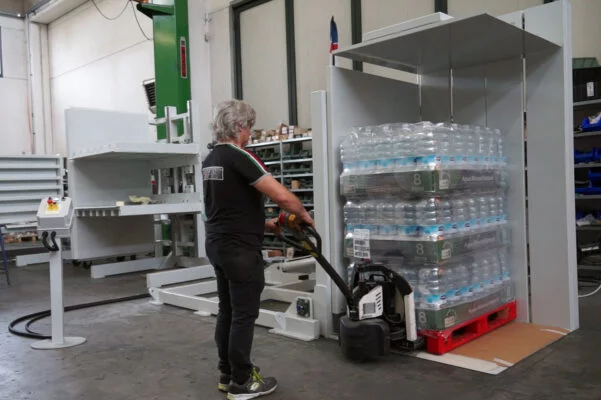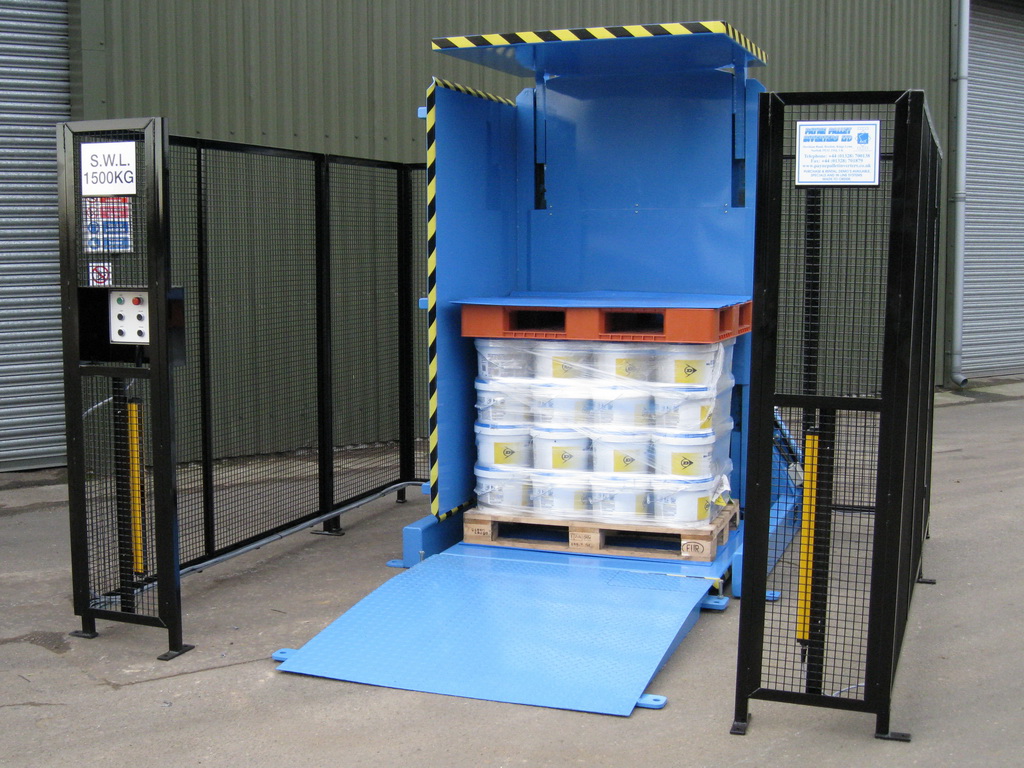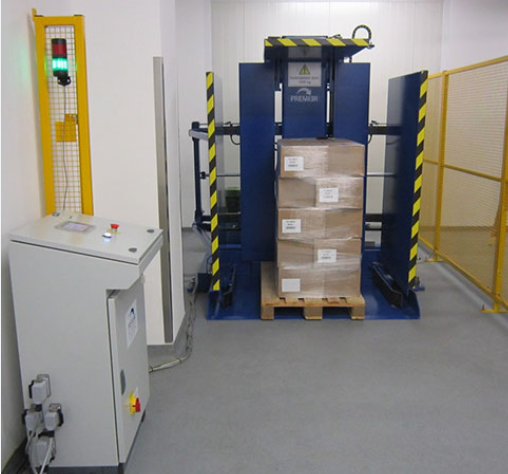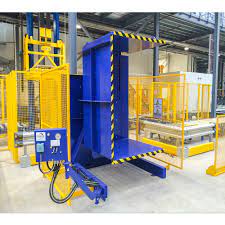Pallet Inverter Safety Tips for Thailand Plants Facing Manual Handling in Food & Pharma Industries
Are you managing a food or pharmaceutical plant in Thailand? If so, you know the daily struggle. Manual handling of heavy pallets is a constant source of risk. It leads to worker injuries, product damage, and operational bottlenecks. The pressure to maintain strict hygiene standards while trying to be efficient feels immense. A single mistake can cause costly downtime or, even worse, a product contamination issue that damages your brand's reputation. It's a high-stakes environment. The solution is not just about working harder, but working smarter and safer. Investing in equipment like a pallet inverter is a great first step, but its real value is only unlocked when safety is at the core of its operation.
The most effective pallet inverter safety tips for plants in Thailand's food and pharma sectors include implementing comprehensive operator training, establishing a strict and regular maintenance schedule, selecting a hygienically designed machine suitable for clean environments, and creating clear, accessible safety protocols for the work area. These steps directly address the risks of both manual handling and machine operation, ensuring compliance and protecting both your staff and your product.

I've spent my entire career in the packaging machine industry, from my early days on the factory floor to building my own company, SHJLPACK. I have seen firsthand how the right equipment can transform a business. But I've also seen how powerful equipment, when used improperly, can create new problems. A pallet inverter is a fantastic tool for efficiency and ergonomics, but it demands respect. In this article, I want to share my direct experience to help you go beyond a simple safety checklist. We will dive deep into the practical steps that turn a pallet inverter into a truly safe and strategic asset for your demanding production environment in Thailand.
How can proper training prevent the most common pallet inverter accidents?
You have made the smart decision to invest in a pallet inverter to reduce manual handling risks. But now you notice a new problem. Your team is hesitant to use it, or they operate it without full confidence. They treat it with a mix of fear and carelessness. This hesitation and lack of knowledge is a recipe for disaster. It can lead to misuse, near-misses, and serious accidents. An untrained operator can easily damage the machine, destroy a full pallet of valuable pharmaceutical or food products, or cause a severe injury. This is not the return on investment you were looking for. The answer is not more warning signs, but a fundamental shift in mindset. Comprehensive training is not just another operational cost; it is a critical investment that protects your people, your product, and your machine. It is what transforms an operator from a simple button-pusher into a skilled and safe controller of the equipment.
Proper training prevents the most common pallet inverter accidents by ensuring every operator understands the correct operating procedures, can identify potential hazards before they escalate, knows the exact steps for emergency shutdowns, and internalizes the reasons behind each safety rule. This comprehensive knowledge replaces uncertainty and bad habits with competence and vigilance, which are the foundations of a safe workplace.

Let's break down what truly effective training looks like. It's more than just handing someone the manufacturer's manual. As an engineer, I believe in building systems, and a training system is no different. It needs structure, practical application, and continuous reinforcement. Simply showing someone the "on" button is not training; it's an invitation for trouble. We need to build confidence and competence from the ground up.
The Foundation: Operator Qualification
Not everyone on the factory floor should be allowed to operate the pallet inverter. The first step is to establish a qualification process. This isn't about exclusion; it's about responsibility. An operator must demonstrate a clear understanding of the machine's purpose and its potential dangers. I always advise my clients to create a formal certification program, even if it's internal. This program should start with classroom-style learning. Go through the manufacturer's manual page by page. Explain the function of every button, every light, and every safety feature like light curtains, pressure-sensitive mats, or safety cages. Discuss the machine's capacity limits. What is the maximum weight? What are the load dimensions? Overloading is one of the most common causes of catastrophic failure.
Building a Hands-On Training Module
After theory comes practice. This must be done under the close supervision of an experienced trainer or a senior operator who has already been certified. The trainee should practice with empty pallets first. Then, they can move to non-critical, stable loads. They must demonstrate proficiency in the entire cycle: loading the pallet, securing the load, operating the inversion cycle, and unloading safely. A critical part of this phase is drilling emergency procedures. What do you do if the power cuts out mid-cycle? Where is the emergency stop button, and what happens when you press it? The operator must be able to react instantly and correctly without panic. Their muscle memory should be trained for safety.
Beyond the Operator: Training for All Involved Staff
Safety is a team effort. The operator is not the only person who needs training. Maintenance staff require specialized training on lockout/tagout (LOTO) procedures to ensure the machine is de-energized before they perform any service. Supervisors and floor managers need to be trained to recognize unsafe practices and enforce safety protocols. They are your first line of defense in maintaining a safe culture. Their job is to ensure that no one takes shortcuts, even when production pressures are high.
| Training Component | Target Audience | Key Learning Objectives | Assessment Method |
|---|---|---|---|
| Basic Operation | New Operators | Machine controls, loading/unloading, cycle start/stop. | Supervised practical test |
| Safety Features | All Operators | Location and function of E-stops, light curtains, guards. | Written quiz & practical demo |
| Emergency Procedures | All Operators | Power failure response, manual overrides, reporting. | Simulated emergency drill |
| Lockout/Tagout (LOTO) | Maintenance Team | Energy isolation points, proper LOTO application. | Practical demonstration |
| Risk Identification | Supervisors, Managers | Recognizing unsafe operation, enforcing protocols. | Observational checklist |
What are the critical maintenance checks for ensuring pallet inverter safety?
Your pallet inverter is a workhorse. It operates shift after shift, flawlessly handling heavy loads and protecting your employees from strain. It seems invincible. Then, one day, without warning, a hydraulic hose bursts. Or a critical safety sensor fails to detect a person in the danger zone. Or a clamping mechanism weakens just enough to lose its grip. This is the moment when a productive asset becomes a liability. A sudden failure can cause a multi-ton load to drop, resulting in catastrophic equipment damage, destruction of high-value products, and life-threatening injuries. Relying on luck is not a strategy. A proactive, disciplined maintenance program is the only way to find and fix these small issues before they become major disasters. It is the difference between preventing an accident and reacting to one.
The most critical maintenance checks for pallet inverter safety involve a multi-layered approach. This includes daily visual inspections of the machine's structure and safety features, weekly checks of hydraulic fluid levels and electrical connections, and monthly operational tests of clamping pressure and safety interlocks. These scheduled tasks ensure the machine operates within its design parameters and that its safety systems are always fully functional.

From my experience running a factory, I can tell you that equipment doesn't just fail overnight. It gives you warnings. A small hydraulic fluid leak, a chain that seems a little too loose, a sensor that sometimes acts up – these are the signs. A robust maintenance plan is your system for listening to what the machine is telling you. Let’s structure what this plan should look like.
The Daily Walk-Around: A Non-Negotiable Routine
Before the start of every shift, the certified operator must perform a quick but thorough walk-around inspection. This is not optional. It should be part of their standard operating procedure, documented on a checklist.
- Visual Check: Look for any signs of damage to the machine frame, guards, or clamping tables.
- Hydraulics: Check for any drips or pools of hydraulic fluid on the machine or the floor. A leak is a clear sign of a failing hose or seal.
- Work Area: Ensure the area around the machine is clean, dry, and free of obstacles.
- Controls: Power on the machine and confirm that all indicator lights are working correctly.
- Emergency Stop Test: This is the most important check. Before running the first load, the operator must press the emergency stop button to confirm it immediately halts all machine movement.
The Weekly and Monthly Deep Dive
These checks are more detailed and may require a trained maintenance person.
- Hydraulic System: Check the fluid level in the reservoir and top up if necessary. Inspect all hoses and fittings more closely for wear, cracks, or abrasions.
- Mechanical Parts: Check the tension and condition of any drive chains or belts. Lubricate all specified moving parts according to the manufacturer's schedule.
- Clamping System: Inspect the clamping surfaces for wear or damage. If the machine has a pressure gauge, verify that the clamping pressure is within the specified range.
- Safety Interlocks: Test the interlocks on any access gates or doors. The machine should stop immediately if a gate is opened during a cycle. Test light curtains by carefully breaking the beam (using an object, not a person) to ensure it triggers a stop.
The Annual Professional Service
At least once a year, it is wise to have a service performed by a technician from the manufacturer or a certified third party. They have the tools and expertise to perform checks that are beyond the scope of daily maintenance. This can include checking the hydraulic pressure relief valve settings, inspecting internal components of the gearbox, and verifying the integrity of the electrical system and control logic. This provides peace of mind and often catches developing issues that are not yet visible.
| Maintenance Task | Frequency | Responsibility | Key Checkpoints |
|---|---|---|---|
| Pre-Shift Inspection | Daily | Operator | E-stop function, leaks, clear work area. |
| Hydraulic & Lube | Weekly | Operator/Maintenance | Fluid levels, hose condition, lubrication points. |
| Safety System Test | Monthly | Maintenance | Gate interlocks, light curtains, pressure sensors. |
| Mechanical Inspection | Quarterly | Maintenance | Chain tension, bolt tightness, structural welds. |
| Full Professional Service | Annually | Certified Technician | Pressure relief valves, electrical system, software. |
Why is selecting the right pallet inverter crucial for food and pharma hygiene in Thailand?
In a general warehouse, a machine is just a tool to move goods. But in your food or pharmaceutical facility in Thailand, every piece of equipment is part of a controlled, sanitary environment. The stakes are completely different. A standard pallet inverter, built for a logistics hub, can become a serious contamination risk in your plant. It might have hidden crevices where bacteria can multiply, be painted with non-food-safe coatings, or use industrial-grade hydraulic fluid that could contaminate your product in case of a leak. A failed GMP audit or, far worse, a product recall due to contamination, can have devastating consequences for your business. The choice of machine is not just an operational decision; it is a critical quality assurance decision.
Selecting the right pallet inverter is crucial for food and pharma hygiene because these industries require specific design features to prevent microbial contamination and comply with stringent regulations like GMP. This means choosing machines built with materials like stainless steel, designed for easy and thorough cleaning (wash-down), and using food-grade components to eliminate any risk of product contamination.

As an engineer who has designed custom packing solutions, I have seen the challenges firsthand. The environment dictates the design. You cannot simply place a standard machine in a cleanroom and hope for the best. You must start with the requirements of hygiene and build the machine around them. For plants in Thailand's vital food and pharma sectors, this is non-negotiable.
Material Matters: Stainless Steel is King
The first and most obvious difference is the material. Most standard industrial equipment is made from painted carbon steel. While strong, paint can chip or scratch. These damaged areas can rust and create microscopic pockets where bacteria can hide and thrive, making true sanitation impossible. For any area with direct or potential product contact, or in wash-down environments, stainless steel is the standard. Specifically, Grade 304 stainless steel is common for its excellent corrosion resistance and cleanability. For environments with harsher cleaning chemicals or saline products, Grade 316L offers superior resistance. It is a more significant initial investment, but it is essential for long-term compliance and safety.
Design for Cleanliness: No Place to Hide
A hygienic design goes beyond just materials. The physical structure of the machine is critical.
- Open Frame: Look for designs that minimize flat surfaces where water can pool. A tubular or "open" frame allows water to drain away freely after cleaning.
- Sealed Welds: All welds should be continuous and polished smooth. Rough or intermittent welds create tiny crevices that are impossible to clean, creating a haven for bacteria.
- No Hollow Sections: Avoid designs with hollow tubes or frames that are not fully sealed. Internal condensation and debris can become a hidden contamination source. Any hollow areas must be hermetically sealed.
System Integrity: Food-Grade and Wash-Down Ready
The components that power the machine also need to be specified for your industry.
- Hydraulics: The system should use a food-grade hydraulic oil. These oils are non-toxic and biodegradable, so a minor leak does not automatically trigger a product quarantine.
- Electricals: Motors, sensors, and control cabinets must have an appropriate Ingress Protection (IP) rating. An IP65 rating means it's protected from water jets, making it suitable for wash-down. For even more demanding cleaning protocols, an IP67 rating (submersion resistant) might be necessary for certain components.
| Feature | Standard Pallet Inverter | Hygienic Pallet Inverter | Benefit for Food & Pharma in Thailand |
|---|---|---|---|
| Construction Material | Painted Carbon Steel | Stainless Steel (304 or 316L) | Prevents rust, no paint chips, easy to sanitize. |
| Design Frame | Solid or Plate Steel | Open, Tubular Frame | Eliminates water pooling, facilitates faster drying. |
| Welds | Standard, may be rough | Continuous, Polished Smooth | No crevices for bacteria to grow. |
| Hydraulic Fluid | Industrial Grade Oil | Food-Grade (H1) Oil | Reduces risk in case of an accidental leak. |
| Electrical Components | Standard (IP54) | Wash-down Rated (IP65+) | Allows for thorough cleaning without damaging electronics. |
My Insights
I have been in this industry for a long time. I started on the factory floor and eventually built my own company, SHJLPACK. I have seen what works and what does not. When I look at a piece of equipment like a pallet inverter, I see more than just steel and hydraulics. I see a system. And the success of that system depends on three things: the machine itself, the people who operate it, and the processes that govern its use.
Many managers focus only on the initial cost of the machine. They look for the cheapest option. This is a short-sighted mistake, especially in the food and pharma industries. A cheap machine with poor safety features or non-hygienic design does not save you money. It creates hidden costs. The cost of one serious accident—in terms of medical bills, compensation, lost production, and legal fees—can be ten times the price difference of a safer machine. The cost of one product recall due to contamination can destroy a brand's reputation, which is priceless.
My advice is to think like an investor, not just a buyer. An investment in proper training is an investment in your people's safety and your operational efficiency. An investment in a rigorous maintenance schedule is an investment in uptime and reliability. And an investment in a hygienically designed, high-quality pallet inverter is an investment in your brand's integrity and your peace of mind.
I remember visiting a food processing plant where a "near miss" occurred. An operator took a shortcut, bypassing a safety guard on their old pallet inverter. A pallet shifted unexpectedly. Nobody was hurt, but an entire load of expensive, finished product was destroyed. The plant manager told me, "Vincent, that incident cost us more in lost product than our entire annual maintenance budget." That single event changed their entire perspective. They realized that safety and efficiency are not opposing forces. They are two sides of the same coin. A safe operation is an efficient operation.
Conclusion
Prioritizing safety through proper training, maintenance, and equipment selection transforms your pallet inverter from a simple tool into a reliable, strategic asset for your plant's success and compliance.




